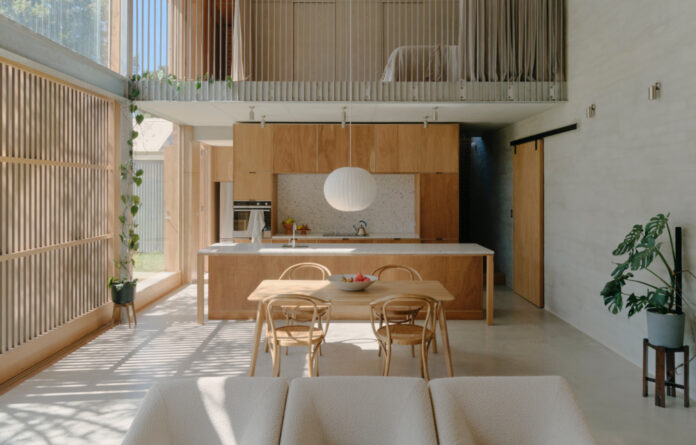[ad_1]
A Post-War Melbourne Home Renovation That References A Signature Robin Boyd Feature
Architecture

Pascoe Vale South house by Chloë Antonio Architecture is reinvented post-war brick home. Styling objects supplied by Bleu Design Store including Oh Hey Grace ceramics and Elizabeth Bell Ceramics.

Chloë Antonio Architecture was recently tasked with ‘rationalising’ and ‘optimising’ the existing home — removing 1980s additions to best utilise the north-facing rear aspect.

The addition houses the north-facing living domain with a mezzanine above the kitchen.

Materials in the addition include concrete, timber, and red bricks that reference the original home.

‘I’m quite proud that among the brutalist materials of concrete and brick there is a gentleness that I can attribute to the orientation,’ says Chloë.

Sculptures and coffee table by Lauren Lea Haynes. Agra Rug in Haze by Armadillo. The previous iteration of this house was fundamentally an internal experience, while the transformed home is connected to its environment and residents.

The view from the mezzanine level. Sculptures provided by Lauren Lea Haynes. Coffee table by Lauren Lea Haynes. Agra Rug in Haze by Armadillo

The mezzanine is a hybrid space operating as a bedroom with en suite, an area for home exercise, a study space, and play space for the children where they are connected to the lower level both visually and acoustically. In Bed bed linen.

Light streams into the mezzanine.

A new en suite. Baina hand towel.

The large wall of windows to the north takes cues from Robin Boyd’s homes. A high eave ensures the sun and shadow travel deep into the living areas in the cooler months.

The post-war brick home has been respected.

The updated home as a smaller footprint to the previous house — 183 square metres plus carport, compared to the previous 205 square metres plus garage.
This post-war house in Pascoe Vale South, Melbourne is located in a heritage precinct featuring several homes built with the assistance of the War Service Homes Commission, who provided affordable housing after the First and Second World Wars.
In the several decades since, the red brick detached home had been modified with internal spaces that lacked natural light and additions spanning almost the entirety of the backyard.
‘The planning of the house did not meet the needs of the young family. The bedrooms were located far away from the parents, the kitchen was “landlocked” in the middle of the house with no natural ventilation, and the home just had a general lack of flow,’ says Chloë Antonio, architect and director of Chloë Antonio Architecture.
The clients came to Chloë to rectify these shortcomings while respecting the character of the home and wider suburban area. The architect has experience working with several award-winning practices including Kerstin Thompson Architects, Lovell Burton, and Jolson, and she also founded Bleu Design Store with her husband in Newtown, Geelong.
Chloë removed the 1980s addition entirely to return the house to its original footprint. ‘This left the whole north wall without a facade and informed the design of the brick threshold defining the old from the new,’ she says.
The remaining southern front of the house was turned into the sleeping quarters, while the addition became the north-facing living domain.
All this was achieved on a smaller footprint to the previous home — (183 square metres plus carport, compared to the previous 205 square metres plus garage) — plus a new mezzanine that creates an extra 33 square metres of flexible floor space above the kitchen.
‘The adaptable layout of the mezzanine means optimising the function while minimising floor area and most importantly optimising the site to allow for the traditional backyard,’ says Chloë.
The addition explores Robin Boyd’s ‘windowall’ concept, as reflected in the new north-facing façade where the structure and window are expressed honestly. ‘The steel structure is articulated independently to the timber windows and doors, enabling an understanding and appreciation for how the building is put together,’ says Chloë.
Materials in the addition include concrete, timber, and red bricks that reference the original home. ‘I’m quite proud that among the brutalist materials of concrete and brick there is a gentleness that I can attribute to the orientation,’ says Chloë. ‘The sun-drenched concrete feels almost soft underfoot, the shadows dance on the brick and concrete canvases adding to the texture of the home. ‘It may sound simple, but the house is a beautiful space for living in.’
The previous iteration of this house was fundamentally an internal experience, while the transformed home is connected to its environment and residents. ‘The home is now flexible in the way it opens to the backyard. As much as the turn of phrase bothers me, it really does mean that you bring the outdoor lifestyle in,’ says Chloë.
‘The façade is further dynamic in the way the screens can be manipulated to provide privacy and shade, giving the family control over how they want to experience the day.’
[ad_2]
thedesignfiles.wpenginepowered.com










